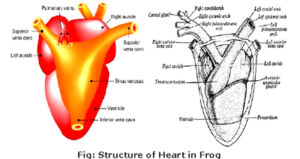About Lesson
CIRCULATORY SYSTEM:-
- The vascular system of frog is well-developed closed type (the blood is enclosed in the vessels and the heart while circulating ).
- Frogs have a lymphatic system also.
- The blood-vascular system involves heart, blood vessels and blood.
- The lymphatic system consists of lymph, lymph channels, and lymph nodes.
- Heart is a muscular structure situated in the upper part of the body cavity.
- It has three chambers, two atria and one ventricle and is covered by a membrane called pericardium.
- A triangular structure called sinus venosus joins the right atrium. It receives blood through the major veins called vena cava.

- The ventricle opens into a saclike conus arteriosus on the ventral side of the heart.
- The blood from the heart is carried to all parts of the body by the arteries (arterial system).
- The veins collect blood from different parts of the body to the heart and form the venous system.
- Special venous connection between the liver and intestine as well as the kidney and lower parts of the body are present in frogs. The former is called hepatic portal system and the latter is called renal portal system.
- The blood is composed of plasma and cells.
- The blood cells are RBC (red blood cells) or erythrocytes, WBC (white blood cells) or leucocytes and platelets.
- RBC’s are nucleated and contain red coloured pigment namely haemoglobin.
- The lymph is different from blood. It lacks few proteins and RBCs.
- The blood carries nutrients, gases and water to the respective sites during the circulation. The circulation of blood is achieved by the pumping action of the muscular heart.
Join the conversation